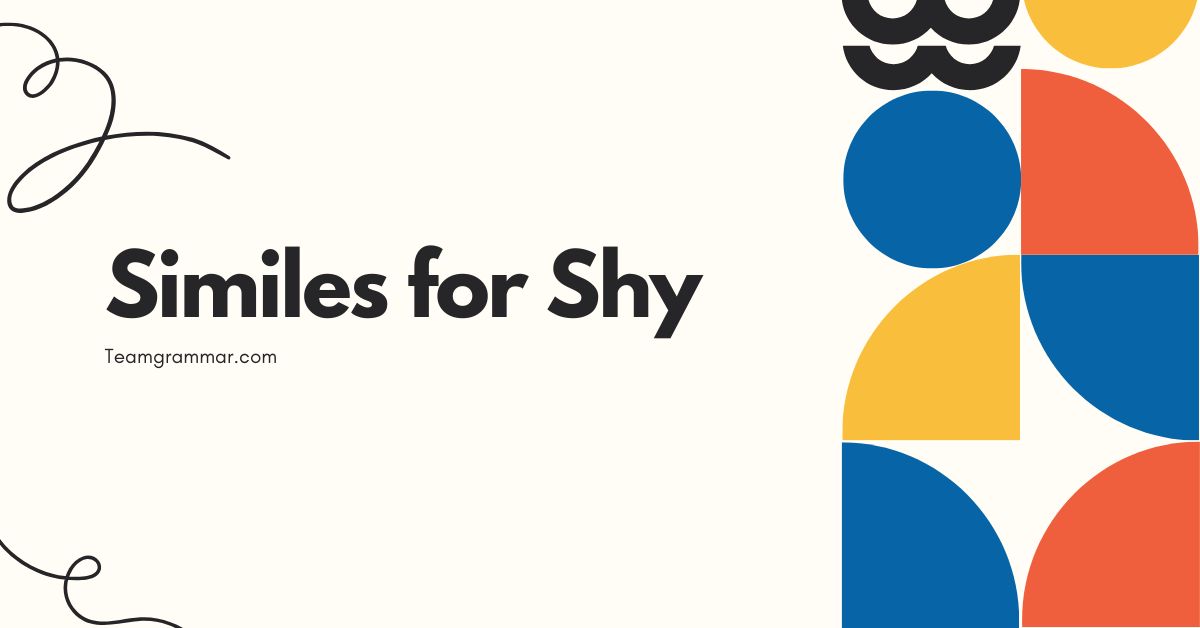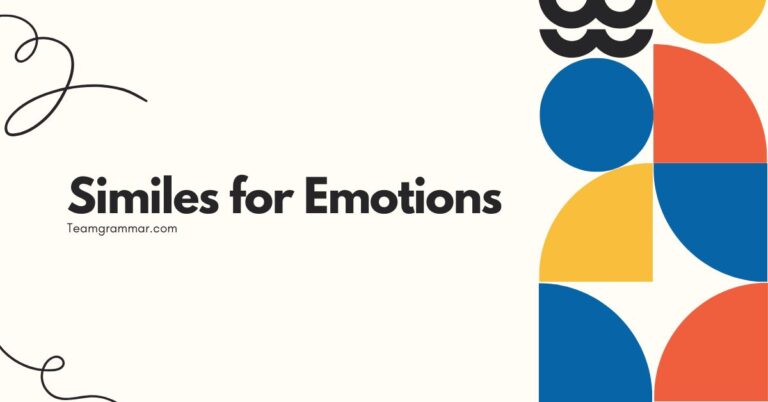49 Similes for Shy: Mastering Figurative Language in English
Understanding similes is crucial for enhancing your descriptive writing and adding vividness to your language. Similes, which compare two unlike things using ‘like’ or ‘as,’ are a fundamental aspect of figurative language.
This article focuses specifically on similes used to describe shyness, providing a comprehensive guide for English language learners, writers, and anyone looking to improve their expressive abilities. By exploring numerous examples and practical exercises, you will gain a deeper understanding of how to effectively use similes to depict shyness in various contexts, enriching your vocabulary and writing style.
Table of Contents
- Introduction
- Definition of Simile
- Classification of Similes
- Function of Similes
- Contexts for Using Similes
- Structural Breakdown of Similes
- Types of Similes
- Direct Similes
- Implied Similes
- Examples of Similes for Shy
- Similes Describing Appearance
- Similes Describing Behavior
- Similes Describing Speech
- Similes Describing Emotions
- Similes Describing Social Interactions
- Usage Rules for Similes
- Clarity and Relevance
- Originality and Creativity
- Appropriateness for Context
- Exceptions and Special Cases
- Common Mistakes with Similes
- Practice Exercises
- Exercise 1: Identifying Similes
- Exercise 2: Completing Similes
- Exercise 3: Writing Similes
- Advanced Topics
- Simile vs. Metaphor
- Extended Similes
- FAQ
- Conclusion
Definition of Simile
A simile is a figure of speech that compares two unlike things using the words “like” or “as.” The purpose of a simile is to create a vivid image or to emphasize a particular quality of one thing by associating it with something else that is familiar to the audience. It is a powerful tool for descriptive writing and can add depth and nuance to your language.
Classification of Similes
Similes can be classified based on their structure and the type of comparison they make. For example, some similes are straightforward and literal, while others are more imaginative and abstract.
Understanding these classifications can help you choose the most effective simile for your intended purpose. Similes can be categorized by the nature of the comparison, such as comparing physical attributes, behaviors, or emotions.
Function of Similes
The primary function of a simile is to enhance description by drawing a parallel between two distinct entities. This comparison serves to illuminate a specific characteristic of the subject, making it more understandable or impactful to the reader.
Similes can also evoke emotions, create imagery, and add stylistic flair to writing. By using similes, writers can engage their audience more effectively and communicate complex ideas in an accessible manner.
Contexts for Using Similes
Similes are versatile and can be used in various writing contexts, including literature, poetry, journalism, and everyday conversation. They are particularly effective in descriptive passages, character development, and persuasive arguments.
The key is to ensure that the simile is appropriate for the tone and audience of the piece. For example, a formal academic paper might require more sophisticated and precise similes than a casual blog post.
Structural Breakdown of Similes
A simile typically consists of three main components: thesubject(the thing being described), thelinking word(either “like” or “as”), and thecomparative term(the thing to which the subject is being compared). The structure is straightforward:Subject + Linking Word + Comparative Term.
For instance, in the simile “He was as quiet as a mouse,” “He” is the subject, “as” is the linking word, and “a mouse” is the comparative term.
Understanding this structure is essential for creating effective similes. The comparative term should be something familiar or easily understood by the audience, and the linking word should clearly indicate the comparison.
The relationship between the subject and the comparative term should be meaningful and relevant to the intended message. The goal is to create a vivid and memorable image in the reader’s mind.
Types of Similes
Similes can be broadly categorized into two main types: direct similes and implied similes. Each type serves a slightly different purpose and can be used to achieve different effects in writing.
Direct Similes
Adirect simileexplicitly uses the words “like” or “as” to make a comparison. This is the most common and straightforward type of simile.
Examples include “She was as pale as a ghost” and “He ran like the wind.” Direct similes are easy to identify and understand, making them a popular choice for writers of all levels.
Implied Similes
Animplied simile, also known as a metaphoric simile, suggests a comparison without directly stating it using “like” or “as.” Instead, it uses more subtle language to hint at the similarity between two things. For example, instead of saying “He was as quiet as a mouse,” you might say “He scurried silently through the room,” implying the comparison to a mouse.
Implied similes can be more creative and engaging, but they also require more skill to execute effectively.
Examples of Similes for Shy
Here are several examples of similes specifically tailored to describe shyness. These examples are categorized to provide a comprehensive understanding of how similes can be used to depict various aspects of shyness, including appearance, behavior, speech, emotions, and social interactions.
Each category offers a unique perspective on the use of similes in describing this trait.
Similes Describing Appearance
These similes focus on how shyness manifests in a person’s physical appearance, such as blushing, avoiding eye contact, or having a timid posture.
The following table provides examples of similes describing the appearance of a shy person.
| Simile | Explanation |
|---|---|
| Her cheeks flushed like roses. | Describes the redness of the cheeks due to shyness. |
| He stood as still as a statue, barely breathing. | Illustrates the physical stillness often associated with shyness. |
| Her eyes darted around like a trapped bird. | Conveys a sense of nervousness and discomfort. |
| He hunched over like a wilting flower. | Depicts a posture of withdrawal and lack of confidence. |
| She was as pale as a sheet when she had to speak. | Describes the paleness caused by anxiety. |
| His hands trembled like leaves in the wind. | Shows the physical manifestation of nervousness. |
| She shrank into herself like a turtle retreating into its shell. | Illustrates the act of physically withdrawing from a situation. |
| He looked as vulnerable as a newborn fawn. | Conveys a sense of defenselessness and innocence. |
| Her gaze was as averted as a shy child’s. | Describes the avoidance of eye contact. |
| He was as stiff as a board when introduced to new people. | Illustrates the physical tension caused by social anxiety. |
| She blushed like a sunset at his compliment. | Describes a strong, visible blush. |
| His shoulders slumped like a defeated warrior’s. | Depicts a posture of dejection and lack of confidence. |
| She seemed as fragile as a glass figurine. | Conveys a sense of delicacy and vulnerability. |
| He stood there like a deer caught in headlights. | Illustrates being frozen by fear or surprise. |
| Her face was as expressionless as a mask. | Describes a lack of emotional display due to shyness. |
| He fidgeted like a child waiting for a scolding. | Shows restlessness and anxiety. |
| She looked as small as an ant in the crowd. | Conveys a sense of insignificance and being overwhelmed. |
| His appearance was as unassuming as a shadow. | Describes a lack of attention-grabbing qualities. |
| She held herself as rigidly as a toy soldier. | Illustrates a tense and controlled posture. |
| He looked as though he wanted to disappear into the floorboards. | Depicts a strong desire to avoid attention. |
| Her eyes were as wide as saucers with anxiety. | Shows intense fear and nervousness. |
| He was as red as a beet after giving his presentation. | Describes intense blushing after a stressful situation. |
| She stood as still as a rock, trying to avoid notice. | Illustrates the desire to remain unseen. |
Similes Describing Behavior
These similes illustrate how shyness affects a person’s actions and reactions in different situations. They capture the essence of shy behavior, from avoiding social interactions to hesitating before speaking.
The following table provides examples of similes describing the behavior of a shy person.
| Simile | Explanation |
|---|---|
| He avoided eye contact like the plague. | Describes a strong aversion to making eye contact. |
| She clung to the wall like a vine. | Illustrates a need for support and a desire to stay out of the spotlight. |
| He moved through the crowd like a ghost. | Conveys a sense of invisibility and a desire to go unnoticed. |
| She hid behind her friend like a shield. | Depicts using someone else as protection from social interaction. |
| He hesitated before speaking like he was defusing a bomb. | Shows the extreme caution and anxiety associated with speaking. |
| She tiptoed around conversations like walking on eggshells. | Illustrates the carefulness and sensitivity in social interactions. |
| He observed the party from a distance like a scientist studying an experiment. | Describes a detached and analytical approach to social events. |
| She blended into the background like a chameleon. | Conveys a desire to avoid attention by becoming inconspicuous. |
| He approached new situations like a cautious explorer. | Illustrates a hesitant and careful approach to unfamiliar environments. |
| She retreated from the conversation like a wave receding from the shore. | Depicts a quick and complete withdrawal from social interaction. |
| He navigated the room like a ship avoiding icebergs. | Shows careful maneuvering to avoid social interactions. |
| She followed her friend like a shadow. | Illustrates a close dependence on someone else for social support. |
| He acted as if he were invisible. | Describes behavior aimed at not being noticed. |
| She stayed in the corner like a potted plant. | Conveys a sense of being stationary and uninvolved. |
| He scurried away from attention like a cockroach when the light is turned on. | Illustrates a quick and panicked retreat from attention. |
| She stuck to familiar faces like glue. | Depicts a strong preference for known and trusted individuals. |
| He avoided the spotlight like a vampire avoids sunlight. | Shows a strong aversion to being the center of attention. |
| She watched the world go by as if she were behind glass. | Conveys a sense of detachment and isolation. |
| He treated social gatherings like obstacle courses. | Illustrates the challenges and anxieties associated with social events. |
| She moved with the stealth of a ninja, avoiding interactions. | Describes a deliberate and skillful avoidance of social encounters. |
| He seemed to be trying to become one with the furniture. | Conveys a desire to blend in and disappear. |
| She acted as if she had a force field around her, keeping people at bay. | Illustrates an unconscious barrier to prevent social interaction. |
| He clung to his phone like a lifeline. | Depicts using technology as a shield in social situations. |
| She seemed to disappear into the crowd, like a drop of water in the ocean. | Illustrates the desire to be lost in a group and unnoticed. |
Similes Describing Speech
These similes capture the hesitant, quiet, or mumbled nature of speech often associated with shyness. They highlight the difficulty shy individuals may have in expressing themselves.
The following table provides examples of similes describing the speech of a shy person.
| Simile | Explanation |
|---|---|
| Her voice was as quiet as a whisper in a library. | Describes a very soft and barely audible voice. |
| He spoke as if he were afraid to break the silence. | Conveys a sense of hesitation and reluctance to speak. |
| Her words came out like hesitant birds taking flight. | Illustrates a slow and uncertain delivery of speech. |
| He mumbled like he had marbles in his mouth. | Describes unclear and indistinct speech. |
| Her speech was as halting as a broken record. | Shows a tendency to pause and stumble over words. |
| He spoke as if each word was a precious jewel. | Conveys a sense of carefulness and deliberation in speech. |
| Her voice trembled like a leaf in the wind. | Describes the shakiness of the voice due to nervousness. |
| He spoke in a monotone like a robot. | Illustrates a lack of emotion and inflection in speech. |
| Her answers were as short as possible. | Describes a tendency to give brief and concise responses. |
| He spoke as if he were reading from a script. | Conveys a lack of spontaneity and naturalness in speech. |
| Her voice was as thin as a thread. | Describes a weak and insubstantial voice. |
| He spoke as if apologizing for every word. | Illustrates a sense of self-consciousness and unease in speaking. |
| Her words trickled out like a slow drip. | Describes a slow and hesitant flow of speech. |
| He spoke as if he were asking a question even when making a statement. | Conveys uncertainty and a lack of confidence in his own words. |
| Her voice was as unsteady as a toddler learning to walk. | Shows the wavering and uncertain nature of her speech. |
| He spoke as if he were afraid someone would contradict him. | Illustrates a fear of being challenged or disagreed with. |
| Her words were as rare as gold. | Describes infrequent and valuable contributions to the conversation. |
| He spoke as if he were confessing a crime. | Conveys a sense of guilt or discomfort in speaking openly. |
| Her voice was as muffled as if she were speaking through a pillow. | Describes unclear and indistinct speech. |
| He spoke with the conviction of a hesitant witness. | Illustrates a lack of confidence in his own testimony. |
Similes Describing Emotions
These similes focus on the internal emotional experience of shyness, capturing feelings of anxiety, fear, vulnerability, and self-consciousness.
The following table provides examples of similes describing the emotions of a shy person.
| Simile | Explanation |
|---|---|
| Her anxiety grew like a weed. | Describes the rapid and uncontrollable growth of anxiety. |
| He felt as exposed as a bare tree in winter. | Conveys a sense of vulnerability and defenselessness. |
| Her self-consciousness was like a heavy cloak. | Illustrates the burden and weight of self-awareness. |
| He felt as small as an atom in the universe. | Describes a sense of insignificance and unimportance. |
| Her fear was like a cold hand gripping her heart. | Conveys the physical and emotional impact of fear. |
| He felt as awkward as a penguin on land. | Illustrates a sense of clumsiness and discomfort in social situations. |
| Her embarrassment washed over her like a tidal wave. | Describes the overwhelming and sudden onset of embarrassment. |
| He felt as though he were walking on eggshells. | Conveys a sense of extreme caution and fear of making a mistake. |
| Her nervousness buzzed inside her like a trapped bee. | Illustrates the restless and irritating nature of anxiety. |
| He felt as defenseless as a turtle without its shell. | Describes a sense of vulnerability and lack of protection. |
| Her heart pounded like a drum in her chest. | Conveys the physical manifestation of anxiety. |
| He felt as if everyone’s eyes were lasers, burning through him. | Illustrates the feeling of being intensely scrutinized. |
| Her shyness was like a wall between her and the world. | Describes the isolating and restrictive nature of shyness. |
| He felt as though he were shrinking into the floor. | Conveys a desire to disappear and avoid attention. |
| Her anxiety felt like a knot in her stomach. | Illustrates the physical discomfort associated with nervousness. |
| He felt as though he were an alien in a foreign land. | Describes a sense of alienation and not belonging. |
| Her fear was as paralyzing as ice. | Conveys the immobilizing effect of intense fear. |
| He felt as though he were drowning in a sea of faces. | Illustrates the overwhelming feeling of being surrounded by people. |
| Her shyness felt like a cage, trapping her inside. | Describes the confining and limiting nature of shyness. |
| He felt as though he were walking a tightrope without a safety net. | Conveys a sense of risk and vulnerability in social situations. |
Similes Describing Social Interactions
These similes capture how shy individuals navigate social situations, often characterized by avoidance, awkwardness, and a preference for solitude.
The following table provides examples of similes describing the social interactions of a shy person.
| Simile | Explanation |
|---|---|
| He blended into the party like wallpaper. | Describes a passive and unnoticed presence in a social gathering. |
| She navigated the crowded room like an obstacle course. | Illustrates the challenges and anxieties associated with social events. |
| He stood on the periphery of the group like an outsider looking in. | Conveys a sense of detachment and exclusion from social interaction. |
| She avoided social gatherings like a vampire avoids sunlight. | Shows a strong aversion to being in social situations. |
| He participated in the conversation like pulling teeth. | Illustrates the difficulty and effort required to engage in social interaction. |
| She clung to her friend like a lifeline in a storm. | Depicts a strong dependence on someone else for social support. |
| He observed the social scene like a scientist studying a specimen. | Describes a detached and analytical approach to social events. |
| She moved through the party like a shadow, unnoticed and unseen. | Conveys a sense of invisibility and a desire to go unnoticed. |
| He engaged in small talk like performing a difficult surgery. | Illustrates the effort and discomfort associated with casual conversation. |
| She remained silent in the group like a statue in a garden. | Describes a passive and non-participatory presence in a social setting. |
| He approached new people like a cautious animal approaching a trap. | Illustrates a hesitant and wary approach to social interactions. |
| She participated in group activities like a reluctant volunteer. | Conveys a lack of enthusiasm and a sense of obligation in social engagement. |
| He stood alone at the edge of the dance floor like a lonely island. | Describes a sense of isolation and detachment from the social activity. |
| She entered the room like a mouse entering a lion’s den. | Illustrates a sense of fear and vulnerability in a social environment. |
| He spoke in social settings like he was walking on thin ice. | Conveys a sense of caution and fear of making a mistake. |
| She smiled politely like a robot following its programming. | Describes a forced and unnatural social interaction. |
| He attempted to join the conversation like a swimmer struggling against the current. | Illustrates the difficulty and effort required to participate in group discussions. |
| She remained on the sidelines of the game like a spectator watching from afar. | Describes a detached and non-participatory role in social activities. |
| He approached social interactions with the trepidation of a soldier entering a minefield. | Conveys a sense of danger and anxiety associated with social encounters. |
| She blended into the background of the party like a piece of furniture. | Illustrates a passive and unnoticed presence in a social gathering. |
Usage Rules for Similes
Using similes effectively requires careful consideration of several rules to ensure clarity, originality, and appropriateness. These rules help to avoid clichés, maintain relevance, and ensure the simile enhances rather than detracts from the writing.
Clarity and Relevance
A good simile should be clear and easy to understand. The comparison should be relevant and make sense to the audience.
Avoid using obscure or overly complex comparisons that might confuse the reader. The purpose of the simile is to enhance understanding, not to obscure it.
For example, instead of saying “He was as shy as a quark,” which might not be familiar to everyone, say “He was as shy as a mouse,” which is a more common and easily understood comparison.
Originality and Creativity
While some common similes are effective, strive for originality and creativity in your comparisons. Avoid clichés and overused phrases.
A fresh and unique simile can make your writing stand out and create a more lasting impression on the reader. Think outside the box and look for unexpected but relevant connections between the subject and the comparative term.
For instance, instead of saying “She was as quiet as a mouse,” try “She was as quiet as a shadow slipping through the night.”
Appropriateness for Context
The simile should be appropriate for the tone and context of your writing. A simile that is too humorous or informal might not be suitable for a serious or academic piece.
Consider your audience and the overall message you are trying to convey when choosing a simile. The simile should enhance the writing, not distract from it.
For example, in a formal essay about psychology, avoid using overly casual or humorous similes. Instead, opt for more sophisticated and precise comparisons.
Exceptions and Special Cases
While the above rules generally apply, there are exceptions and special cases where breaking these rules can be effective. For example, using a cliché ironically can add humor or satire to your writing.
However, these exceptions should be used deliberately and with a clear understanding of their potential impact on the audience.
Common Mistakes with Similes
Several common mistakes can undermine the effectiveness of similes. Recognizing and avoiding these errors can significantly improve the quality of your writing.
Incorrect: He was shy like he was shy.
Correct: He was as shy as a mouse.
Explanation: The incorrect example is tautological and doesn’t provide any comparison. The correct example uses a simile to create a vivid image.
Incorrect: She was as shy as a refrigerator.
Correct: She was as shy as a newborn fawn.
Explanation: The incorrect example uses an irrelevant and nonsensical comparison. The correct example uses a comparison that is relevant and evokes a sense of vulnerability.
Incorrect: He was shy like everyone knows.
Correct: He was as shy as someone hiding in the dark.
Explanation: The incorrect example is vague and lacks a specific comparison. The correct example uses a simile to create a clear and understandable image.
Practice Exercises
Test your understanding of similes with these practice exercises. Each exercise focuses on a different aspect of simile usage, from identification to creation.
Exercise 1: Identifying Similes
Identify the similes in the following sentences.
| Question | Answer |
|---|---|
| 1. She was as quiet as a whisper. | as quiet as a whisper |
| 2. He ran quickly to the store. | No simile |
| 3. The moon was like a silver coin in the sky. | like a silver coin |
| 4. The car sped down the road. | No simile |
| 5. He was as pale as a ghost. | as pale as a ghost |
| 6. She hid like a child. | like a child |
| 7. The sun shone brightly. | No simile |
| 8. He was as red as a tomato. | as red as a tomato |
| 9. She sang beautifully. | No simile |
| 10. He was as brave as a lion. | as brave as a lion |
Exercise 2: Completing Similes
Complete the following similes with an appropriate ending.
| Question | Answer |
|---|---|
| 1. She was as quiet as a _____. | mouse |
| 2. He was as pale as _____. | a ghost |
| 3. The moon was like a _____. | silver coin |
| 4. She was as red as _____. | a beet |
| 5. He was as brave as _____. | a lion |
| 6. She was as fast as _____. | the wind |
| 7. He was as slow as _____. | a snail |
| 8. She was as bright as _____. | the sun |
| 9. He was as dark as _____. | night |
| 10. She was as tall as _____. | a tree |
Exercise 3: Writing Similes
Write your own similes to describe the following:
| Question | Answer |
|---|---|
| 1. A shy person’s voice. | Their voice was as soft as a feather. |
| 2. A shy person’s smile. | Their smile was like a sunrise, slow and hesitant. |
| 3. A shy person entering a room. | They entered the room like a ghost, barely making a sound. |
| 4. A shy person’s laugh. | Their laugh was as rare as a blue moon. |
| 5. A shy person’s eyes. | Their eyes darted around like a frightened bird. |
| 6. A shy person’s walk. | They walked as if they were trying not to be seen. |
| 7. A shy person’s handshake. | Their handshake was as gentle as a breeze. |
| 8. A shy person’s response. | Their response was as brief as possible. |
| 9. A shy person’s presence. | Their presence was as subtle as a shadow. |
| 10. A shy person’s departure. | They departed like a whisper fading into the night. |
Advanced Topics
For advanced learners, understanding the nuances of similes and their relationship to other figures of speech can further enhance their writing skills.
Simile vs. Metaphor
While both similes and metaphors are figures of speech that make comparisons, they differ in their approach. Asimileuses “like” or “as” to make an explicit comparison, while ametaphorimplies a comparison without using these words.
For example, “He is like a lion” is a simile, while “He is a lion” is a metaphor. Metaphors are often considered more powerful and direct, but they also require more careful execution to avoid confusion.
Extended Similes
Anextended simileis a simile that is developed over several lines or even an entire paragraph. This allows for a more detailed and nuanced comparison, creating a richer and more vivid image in the reader’s mind.
Extended similes are often used in poetry and descriptive prose to create a particular mood or atmosphere. They allow the writer to draw out multiple points of comparison, enhancing the impact of the figure of speech.
FAQ
Here are some frequently asked questions about similes.
- What is the difference between a simile and a metaphor?
A simile uses “like” or “as” to make an explicit comparison, while a metaphor implies a comparison without using these words. A simile says something is like something else, while a
simile states that something is something else.
- Can a simile be a cliché?
Yes, if a simile is overused and lacks originality, it becomes a cliché. It’s best to strive for fresh and unique comparisons.
- How do I create a good simile?
Start by identifying the key characteristic you want to emphasize, then think of something that shares that characteristic in a vivid or unexpected way. Use “like” or “as” to connect the two.
- Is it okay to use similes in formal writing?
Yes, but use them sparingly and ensure they are appropriate for the tone and audience. Avoid overly casual or humorous similes in formal contexts.
- What if my simile doesn’t make sense to everyone?
Aim for comparisons that are generally understandable, but don’t be afraid to use more sophisticated similes if your audience is likely to appreciate them. Consider providing context if necessary.
Conclusion
Mastering the use of similes can significantly enhance your writing and communication skills. By understanding the structure, types, and usage rules of similes, you can create vivid and memorable descriptions that engage your audience and convey your message more effectively.
Whether you are describing the appearance, behavior, speech, emotions, or social interactions of a shy person, similes provide a powerful tool for adding depth and nuance to your language. Practice using similes regularly, and don’t be afraid to experiment with different comparisons to find the ones that work best for you.
With practice, you’ll be able to use similes to bring your writing to life and express yourself with greater clarity and creativity.







